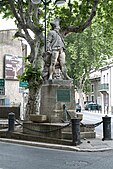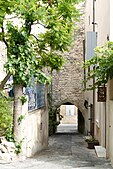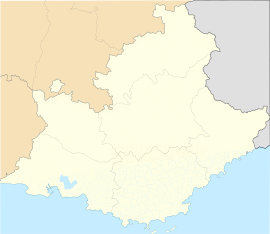Saint-Cannat
Saint-Cannat | |
|---|---|
 Town hall | |
 Coat of arms | |
show Location of Saint-Cannat | |
 Saint-Cannat | |
| Coordinates: 43°37′12″N 5°17′55″E / 43.62°N 5.2986°ECoordinates: 43°37′12″N 5°17′55″E / 43.62°N 5.2986°E | |
| Country | France |
| Region | Provence-Alpes-Côte d'Azur |
| Department | Bouches-du-Rhône |
| Arrondissement | Aix-en-Provence |
| Canton | Pélissanne |
| Intercommunality | Aix-Marseille-Provence |
| Government | |
| • Mayor (2020–2026) | Jacky Gérard |
| Area 1 | 36.54 km2 (14.11 sq mi) |
| Population (Jan. 2018)[1] | 5,678 |
| • Density | 160/km2 (400/sq mi) |
| Time zone | UTC+01:00 (CET) |
| • Summer (DST) | UTC+02:00 (CEST) |
| INSEE/Postal code | 13091 /13760 |
| Elevation | 159–391 m (522–1,283 ft) (avg. 212 m or 696 ft) |
| 1 French Land Register data, which excludes lakes, ponds, glaciers > 1 km2 (0.386 sq mi or 247 acres) and river estuaries. | |
Saint-Cannat (French pronunciation: [sɛ̃ kana]; Occitan: Sant Canat) is a commune in the Bouches-du-Rhône department in southern France.
History[]
The village was named after Canus Natus, a fifth century Roman Catholic Saint, who was a Roman clergyman born with white hair, a quirk synonymous with great wisdom at the time.[2] He was buried in Saint-Cannat, although there was no such place at the time, but soon enough several houses were built into a hamlet.[2]
In the twelfth century, Archbishop Pierre mentioned, 'Castrum Santi - Cannati' in a paper.[2]
In the thirteenth century, villagers turned on their archbishop and pledged allegiance to the Lord of the Baux-de-Provence, and then to the Kings of Sicily (namely, Frederic III of Aragon, or perhaps Louis XIII).[2] This, however, only lasted three years.[2] In the same century, the Knights Templar established a settlement there.[2]
Pierre André de Suffren was born here on 17 July 1729.[2] A century later, Alphonse Tavernier, a poet, was born here on 27 November 1852.
On June 11, 1909, a terrible earthquake destroyed almost everything.[2] Shortly after, the houses were re-built in the same architectural style.[2] Both in 1984 and 1994 huge floods ravaged most houses.[2]
It has retained several fountains dating back to the 17th and 18th century, the remains of the medieval ramparts and the chateau, which today houses the town hall and museum.[2] The Route nationale 7 bisects the village.
There is a polo club, Polo Club de Saint Cannat, opened in the 1970s.[3] It organizes the Open d'Aix and the Tournoi de Noel every year.[4]
There is also an entertainment park called Village des automates.[5]
It is also home to the winery Château de Beaupré, started by Baron Emile Double (1869-1938) in 1890.[6]
The creek flows through the village.
Population[]
|
|
Gallery[]

Roman Catholic church

Statue of Pierre André de Suffren

War memorial

An alley in Saint-Cannat
References[]
- ^ "Populations légales 2018". INSEE. 28 December 2020.
- ^ Jump up to: a b c d e f g h i j k official website Archived 2007-05-18 at the Wayback Machine
- ^ Polo Club de Saint Cannat
- ^ Horace A. Laffaye, The Polo Encyclopedia, Jefferson, North Carolina: McFarland & Company, 2004, p. 330
- ^ Village des automates
- ^ History
External links[]
| Wikimedia Commons has media related to Saint-Cannat. |
- Communes of Bouches-du-Rhône







